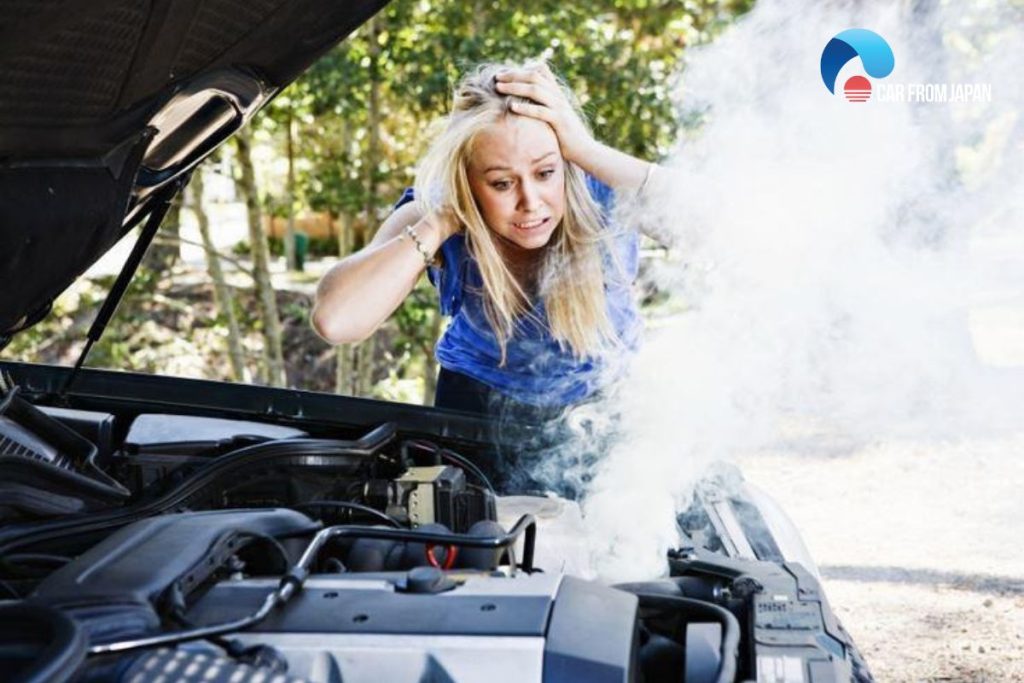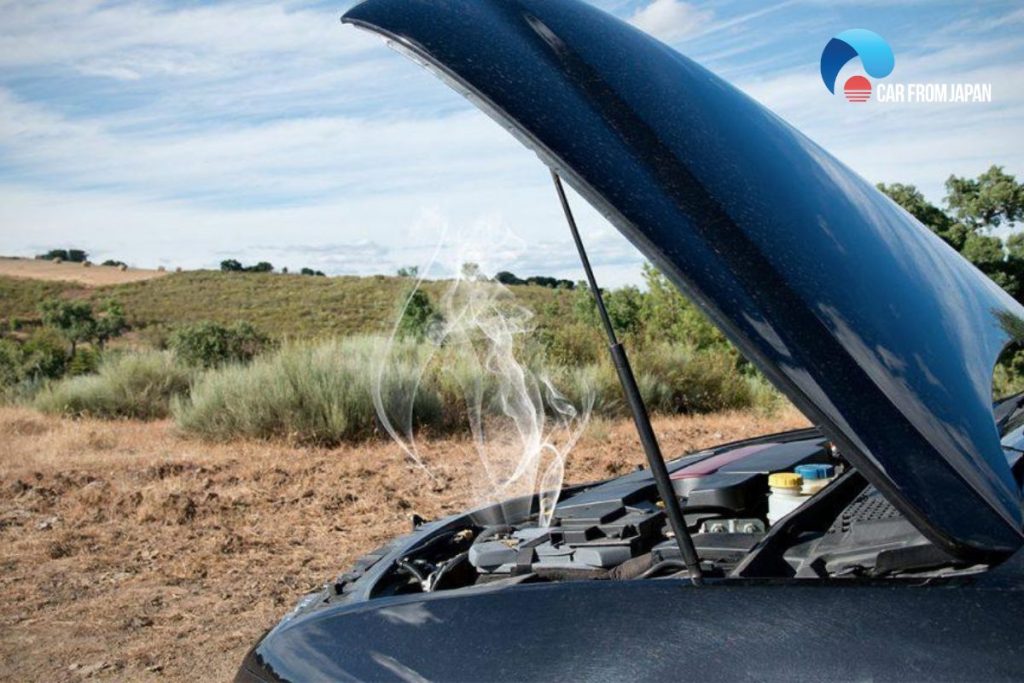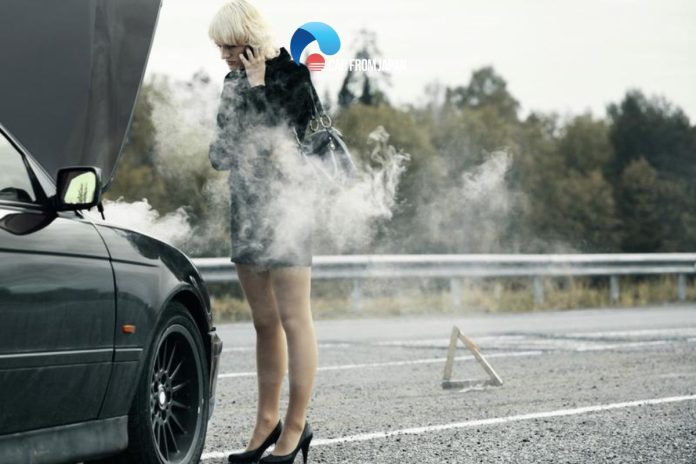Whether the car smoking under hood but not overheating or the tailpipe belching smoke, it’s an indication of a more serious problem.
The exhaust pipe smoke could be of various colors and each color indicates a specific problem. But, that’s another topic. We’re going to discuss here why there is white smoke coming from under hood but not overheating.
Contents
- 5 Reasons For Car Smoking Under Hood But Not Overheating
- What To Do When Car Blowing White Smoke But Not Overheating?
- FAQs on Car Smoking Under Hood Not Overheating
- Why does the smoke smell like gasoline?
- Why doesn’t your car start but still have white smoke?
- Why does the smoke come from the car when it’s cold?
- Why does my car smoke under the hood only when I stop at traffic lights?
- Why does my car smoke under the hood only in rainy or humid weather?
- Why does my car only smoke under the hood after a car wash?
- Final Words
5 Reasons For Car Smoking Under Hood But Not Overheating
There could be several reasons for car smoking but not overheating. These are not serious issues but could turn serious if you don’t find out the root of the problem and fix it. The most common causes of this trouble are.
Oil spillage
If the car smoking under hood but not overheating, it could happen due to the presence of oil outside the engine where it does not belong.
Oil could go there when you are not careful when filling up the gas tank. Or, a spill could occur when you are adding oil to the crankcase.
If it is just an oil spill at the wrong place, it won’t do any major harm except for producing a harsh, oily smell. It will quickly burn off without causing any long-term damage.
However, if spills are a regular occurrence and you keep driving without wiping them off, some rubber or plastic parts could break down due to being submerged in oil for a long time.

A leaky component
It’s another form of oil spillage but the oil, in that case, oozes from a leaky component sitting high on the engine. It could be a leaky valve cover gasket that particularly happens in V-configured engines.
Replacing the valve cover gasket is an easy and cheap fix. However, ignoring the problem for too long will turn the minor leak into a bigger one and deteriorate the problem.
Bad oil filler cap
White smoke coming from hood of car not overheating is a common issue in older engines.
The oil filler cap in almost all the engines releases a faint whiff of smoke, which is a residue of burnt fuel inside the engine. Older engines produce more hot spots, which makes the car smoking under hood but not overheating.
Worn-out piston rings and clogged PCV tubes or valves are the culprits that cause this smoking issue. The timeworn rings make the pistons siphon fuel into the cylinder where it burns and creates smoke.
The smoke then gets past the piston rings. The crankcase ventilation is supposed to pull the smoke back into the engine for burning again.
However, this does not happen when either the PCV tube or valve is faulty or blocked. In that case, the smoke gets released through the oil filler cap.
Read More: Smoke from Oil Cap? Find the Solutions
Electrical wires
A hot wire could also be the reason for engine smoking but not overheating. In that case, you will smell a pungent odor that is hard to miss. It’s hard to trace when it comes from the alternator’s copper wires.
It oozes a subtle aroma-like smell that comes from ozone and hot metal. Nevertheless, you will get a strong odor if the alternator is burnt out completely. If that happens, the low voltage and check engine lights will also come on.
Coolant leak
If there is a leak in the coolant overflow tank, it can cause occasional cases of steam coming from under hood but not overheating.
The occasional smoke puffs can also be the aftermath of leaked and burned power steering or transmission fluid. In that case, there will be a cloud of smoke accompanied by a hint of chemical odor.

What To Do When Car Blowing White Smoke But Not Overheating?
In most cases, smoking coming from under the hood is not a major issue. However, you have to be careful and follow some rules to keep it that way.
- The smoking problem may cause showing low pressure in the oil gauge or light up the oil pressure indicator. If that happens, don’t keep driving the car. Take it to an auto servicing shop as soon as possible.
- If you detect smoke and low oil pressure while driving on the highway, try to park somewhere safe and shut off the engine. If you have an extra gallon, add it to the fuel tank and restart the engine. Drive carefully to a safe place or a repair shop if the oil pressure improves or the light goes off.
- Check the coolant: When you see white smoke in the car and a musty, unpleasant smell, it may be because the cooling water has evaporated or the transmission oil is burned.
- Check and clean the fuel filter, air filter, and oil filter. Replace them if necessary.
- Take your car to a trusted service center for inspection and repair.
FAQs on Car Smoking Under Hood Not Overheating
Why does the smoke smell like gasoline?
White smoke coming out of the exhaust that smells like gasoline could be caused by a problem with the car’s carburetor.
At this time, the amount of fuel entering the carburetor is more than usual, leading to an uneven ratio of gasoline and oxygen, causing the gasoline to not be fully burned and follow the gas to the outside.
Why doesn’t your car start but still have white smoke?
The car won’t start but still has white smoke which is a sign that oil is leaking inside the engine.
Drivers need to check the quality and signs of damage to the tank to take timely measures to replace it.
Why does the smoke come from the car when it’s cold?
Normally, the problem of white exhaust gas, when it is cold, will occur in diesel engines because the fuel has not been burned or the liquid has not entered the engine.
To handle this situation, drivers need to give their vehicle to a service center to have professional technicians check the oil level and quality of the tank and offer an effective solution.
Why does my car smoke under the hood only when I stop at traffic lights?
This could be due to a small fluid leak (oil, coolant, or power steering fluid) dripping onto a hot surface, but only producing visible smoke when airflow is reduced while idling.
Why does my car smoke under the hood only in rainy or humid weather?
Moisture can mix with minor oil or coolant leaks, producing steam or light smoke.
Additionally, if water enters the alternator or electrical components, it may cause short-term car steam coming from under hood but not overheating.
Why does my car only smoke under the hood after a car wash?
Water may have entered sensitive areas, causing steam or electrical shorting. If the smoke has a burnt smell, check for wiring issues.
Watch this video from to DIY-time to learn more about the car smoking diagnose!
Final Words
In general, notice your car smoking under hood but not overheating is easy but to diagnose it, you need more time and evidence. Pay attention to the smoke’s color, smell, and location or other symptoms such as coolant leak, oil spillage, or air filter cap at fault.
Address the problem promptly to ensure your vehicle’s safe and reliable operation!
For more insightful Car maintenance tips, follow Car From Japan today!




Add oil to your fuel tank?? Are you sure???
Yeah, not sure if adding oil to the fuel tank is a good idea… But what do I know 🤷🏼♂️